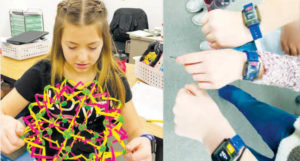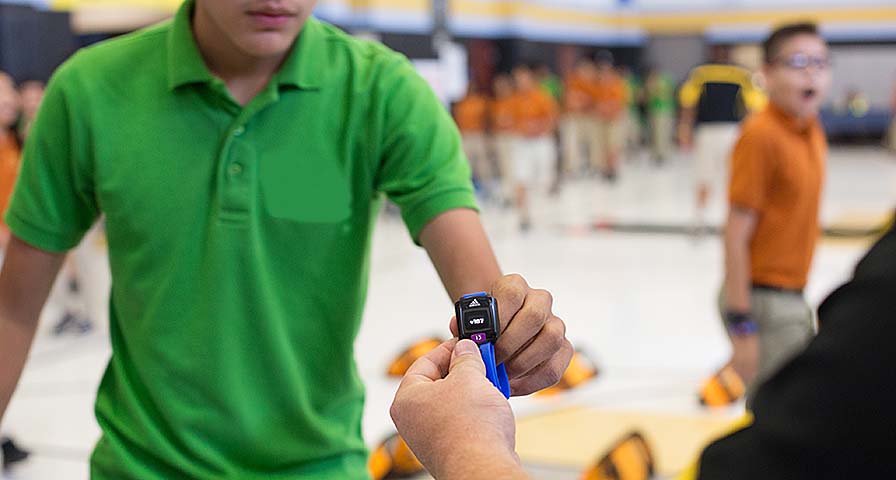Schools using IHT ZONE heart rate monitors to teach students to manage their physical and emotional health don’t follow the same path to success.
As education specialist Dr. Brad Johnson tweeted on July 13, “You can walk in 5 different classrooms and see 5 different teachers connecting with students in 5 different ways.”
Similarly, from individual classrooms to district-wide solutions, schools continue to use their IHT ZONES in ways that make the biggest difference for their students. Examples include:
- Braham Area Schools teaching students about emotional self-regulation
- Littleton Public Schools working with students to manage emotions
- Little Falls Middle School helping students rebound from lost physical activity opportunities
- San Bernardino CUSD reinventing its high school PE program
- IDEA Public Schools utilizing PE as a key component of academic achievement
Heart Rate Monitors and Student Social-Emotional Health
When her Braham Area (Minn.) Schools students asked about the heart rate monitor on Jonelle Klemz’s arm, the counselor explained what the monitor showed her throughout the day.
“As I work with kids, I’m always thinking about ways I can see if they’re really learning (what we’re teaching),” Klemz said. “Sometimes I say, ‘well, you be the teacher and you see if you can get my heart rate down by teaching me the breathing things we’ve learned.’”
Klemz uses Hoberman Spheres and other breathing techniques to help students learn to calm themselves down. The heart rate monitor she started wearing five years ago helped her show students how the techniques can work. Students became so focused on her monitor that they wanted to wear it for themselves to see if the techniques worked as quickly.
“Several times kids asked if they could wear mine or wished they had their own,” Klemz said. “One day I had several kids ask me and really were kind of frustrated with me that I couldn’t give them my own device.”
 That day prompted Klemz to research heart rate monitors. She found a story posted by NBC News: a Today Show segment on a Littleton (Colo.) Public School program using IHT ZONE heart rate monitors to teach students to manage their emotions. Select elementary school students across LPS wear heart rate monitors throughout the day. When they notice that their heart rate doesn’t match their activity level, they can employ some calming techniques they’ve learned from school counselors.
That day prompted Klemz to research heart rate monitors. She found a story posted by NBC News: a Today Show segment on a Littleton (Colo.) Public School program using IHT ZONE heart rate monitors to teach students to manage their emotions. Select elementary school students across LPS wear heart rate monitors throughout the day. When they notice that their heart rate doesn’t match their activity level, they can employ some calming techniques they’ve learned from school counselors.
“Our goal was to address the social and emotional self-regulation needs of our students,” East Elementary School Principal Kelly Card said. “We were looking for something that was going to be durable, that was going to be light, user-friendly for students, and we wanted it to look cool.”
Card and counselor Kim Bailey discovered the IHT ZONE wrist heart rate monitor, which shows students both their actual heart rate and the color representing the heart rate zone they are currently in. The colors correspond to both physical activity and emotional state:
- Blue indicates resting heart rate or calm and happy
- Yellow indicates elevated heart rate or excitement or frustration
- Red indicated vigorous heart rate or high levels of stress or anger
Students said they improved their ability to manage their emotions and behaviors by controlling their heart rate.
“I was really emotional and now I’m a little bit stronger and calmer,” second-grade student Charlotte Sherwood said. “I feel it’s made a big difference since I started wearing the monitor.”
The program proved so successful that the NBC Today Show featured Littleton’s Operation Dragon Heart on its weekend broadcast in Jan. 2020.
Creating Physical Education Programs that are Engaging for Students
When students returned to campus after the pandemic, teachers noticed that many missed the moderate to vigorous physical activity they had relied on physical education classes to provide.
 “When we came back, it was a big shock to everyone,” Little Falls (Minn.) Middle School PE teacher Nick Abbott said. “Other teachers noticed that many of our students were heavier than when they were last on campus. It’s been a process, but we’re getting back to a routine and getting after it.”
“When we came back, it was a big shock to everyone,” Little Falls (Minn.) Middle School PE teacher Nick Abbott said. “Other teachers noticed that many of our students were heavier than when they were last on campus. It’s been a process, but we’re getting back to a routine and getting after it.”
Abbott and PE colleague Leanne Grosso provided students with IHT ZONE heart rate monitors. The monitors enabled students to push themselves to achieve individual goals designed to improve their physical fitness at their own pace. One student doesn’t have to run as fast as another to get a meaningful workout.
“Everybody’s version of hard work is so different,” Abbott said. “With (the heart rate monitors), we have an objective tool that we can use. This is science talking and you have much more to give yourself. I like to direct things that way. ‘You owe this to yourself, to your own health.’”
San Bernardino City USD teacher Scott Smith realized the motivational power of the IHT ZONE heart rate monitors when he essentially recreated a PE program that struggled to meet student needs.
“We couldn’t keep going down this path,” Smith said. “We weren’t getting results and we were not meeting the needs of all our students. Every day was a struggle just to get through the day.”
 Using student feedback and funding he earned through an Innovation Grant, Smith turned his program around. The final piece became the IHT ZONE monitors, which showed students they had the power to control their individual workouts.
Using student feedback and funding he earned through an Innovation Grant, Smith turned his program around. The final piece became the IHT ZONE monitors, which showed students they had the power to control their individual workouts.
“I knew this would have a big impact, but I didn’t think it would be this big,” Smith admitted. “The heart rate monitors have super-charged our program. You can see it in the body language of the students, the look on their faces. As soon as we gave them the heart rate monitors, they really felt at that time that we really cared about them as individuals.”
Incorporating Physical Fitness into Academic Development
Despite the growing number of reports detailing the link between physical activity and academic readiness, schools often minimize the time students have for physical activity. Across its growing network, the IDEA Public Schools continue to prove the many reports by continuing to commit to providing students with opportunities for moderate-to-vigorous physical activity.
IDEA relies on the IHT ZONE heart rate monitor to show students their effort level and prove that their philosophy remains correct.
“People understand why we are using this technology,” said Eren Kirksey, IDEA’s PE Curriculum Manager. “We can see that the kids are focusing better when they come back into the classroom. It is amazing how this simple tool has bridged an entire district.”
A few years ago, IDEA saw five of its high school campuses earn spots in the top 10 on the Washington Post’s list of most challenging high schools.
The rankings reinforce Kirksey’s curriculum initiatives, which maintain that students get enough time for physical activity – circuit-based workouts designed to get students exercising at an elevated heart rate – to maximize their academic performance. Principals and academic leaders see the difference the enhanced PE program has had on students and changed the way they address students who may have academic struggles.
“The commitment to physical activity is a primary factor in how we’re going to get our kids to be able to grow to success as they head into the real world,” Kirksey said.


